
Barone Pasquale RevoltellaPasquale Revoltella (1795 – 1869) was an entrepreneur and financier of Venetian origin. He was one of the most outstanding and authoritative figures of imperial Trieste and played a major role in both economic and political affairs. He belonged to a family of merchants who arrived in Trieste in 1797 when he was only two; presumably having left Venice due to the fall of the Republic. He started working while still very young, immediately displaying considerable entrepreneurial ability. After a lengthy apprenticeship with the business firm owned by Teodoro Necker, the Swiss consul in Trieste, in 1835 he set up a timber and grain import company which thrived rapidly.
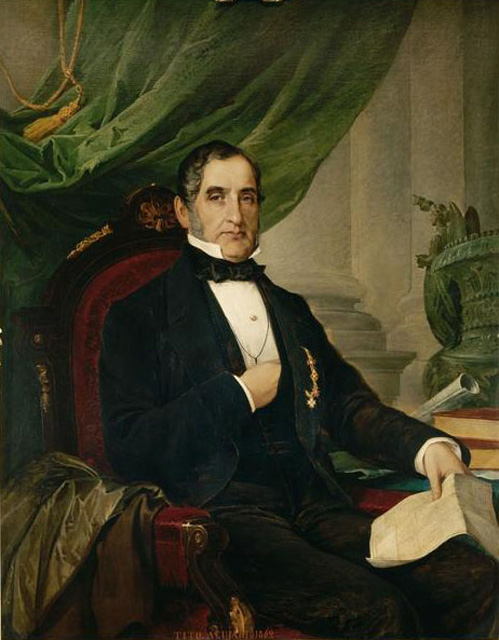
At the same time he started his career as a financier. He was one of the first shareholders of Assicurazioni Generali (Generali group – founded in 1831) and became a member of the board of directors of Austrian Lloyd (founded in 1833). He also worked as town councillor and deputy of the Stock Exchange.
A number of influential connections were crucial to Revoltella’s rise, among these his close friendship with Baron Carlo Ludovico de Bruck. De Bruck was one of the founders of Lloyd and was elected deputy in 1848; he subsequently became Minister of Trade and Finance of the Viennese government.
Revoltella’s strong attachment to his adopted town induced him to invest considerable financial resources in philanthropic and educational initiatives: in 1850 he founded a drawing school, in 1853 he donated an altar to the Church of S.Maria Maggiore and in 1857 he supported the building of the “Ferdinandeum” (a commemorative building dedicated to Archduke Ferdinand, brother to the Austrian Emperor) and the construction of the Armonia Theatre.
During 1854 to 1858 he also built two new residences for himself: a sumptuous palace in town and a Swiss style chalet on the hillside known as the Collina del Cacciatore (Hunters Hill). However, his main endeavours were concentrated on facilitating the opening of the Suez Canal which he believed to be crucial to developing Trieste’s sea trade economy. In 1858 he travelled to Paris to offer Ferdinand de Lesseps Trieste’s participation in the great venture. In February 1859 de Lesseps visited Trieste and met the city representatives in the reception rooms of the new Revoltella Palace, along with another illustrious guest, the Archduke Maximilian of Hapsburg, Governor of Lombardy and Veneto, who was at the time supervising the construction of Miramare Castle on the promontory of Grignano.
Revoltella was nominated Vice President of the Universal Company of the Suez Canal and in 1861 he set out on a long journey to Egypt to visit the operations site. He returned with numerous reminiscences and a travel journal which continues to be conserved in his library. He subsequently continued to work in support of the project and in 1864 he published an essay entitled “The co-participation of Austria in World Trade” where he sustained views of Trieste’s pivotal role in the network of economic relationships between Europe and the rest of the world.
He devoted the last years of his life to patronage and the completion of his Cacciatore residence – where he also erected a church, dedicated to St. Pasquale, which was to later house his remains. In 1867 he was vested by the Austrian Empire with the title of Baron.
He died after a long illness on September 8th 1869, only a few months before the inauguration of the Suez Canal in November. Having remained unmarried he left virtually all the great fortune he had accumulated during his lifetime to his city.
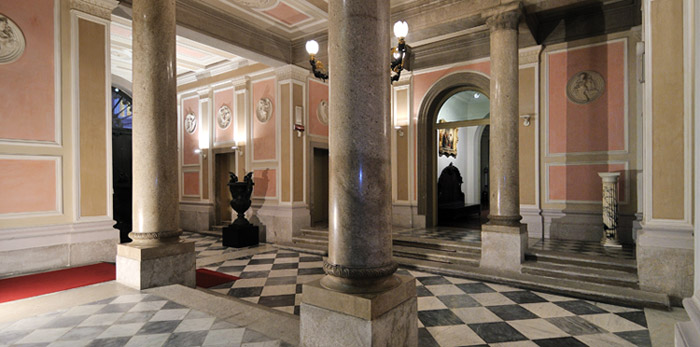
In 1852 Revoltella entrusted Berlin architect Friedrich Hitzig, a disciple of the celebrated Schinkel, the design of the palace he intended to have built in the proximity of the sea front on Piazza Giuseppina. Born in Berlin in 1811, Hitzig was considered a rising star in his home country. He had travelled to Paris in 1835, where he was struck by the works of Percier and Fontaine, and to Italy in 1845. He was the first architect of his generation to work mainly in the field of private construction. Unfortunately his Berlin buildings (a series of villas on Victoria Strasse) were largely destroyed during World War II. How he met Pasquale Revoltella is still, on the whole, rather unclear. But in January 1853 Hitzig presented Revoltella with a design which constituted for Trieste an unprecedented architectonic departure. It had Neo-Renaissance stylistic traits, based presumably on French architectural models.
The façade is divided into three storeys by elaborate string-courses which mark the different surface texture treatments and the transition from the austere style of the ground floor to the increasingly refined decoration of the upper storeys. The most striking element is the triple arched windows of the central galleries with two columns and an upper frame which encloses a richly decorated entablature with medallions in relief.
On the highest part of the building there is a band with two protruding frames and a balustrade continuing the decorative pattern on the mullions of the balcony below. The balustrade runs around the building and is interrupted by plinths supporting six allegorical statues by the Venetian sculptor Francesco Bosa. Hitzig’s design was to represent both a continuation and a disruption for contemporary Triestine architecture; his stylistic references did not deny classicism but he had contradicted the traditional composition of the Neo-classical façade.
From home to museum
The development of the collection and the creation of the Gallery of Modern Art
In 1872, three years after the Baron’s death, in accordance with arrangements expressed in his will, the palace became the “Revoltella Museum”. It was managed by a Board of Trustees who administered the funds deriving from his inheritance and made provisions for the steady increase of the art collection – which had doubled in its number of art works in less than thirty years. In 1907 it became necessary to enlarge the museum as it had become too small to house the whole collection.
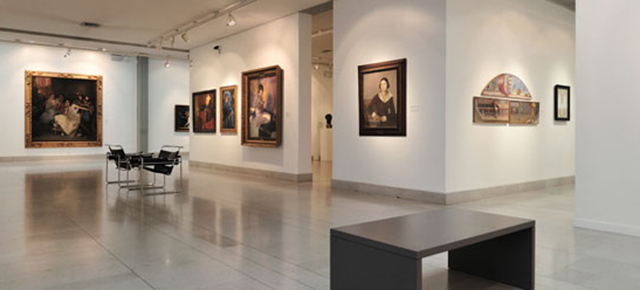
The City Council therefore purchased the adjacent Brunner palace but it was only after the first World War that it began to be used as exhibition space. In 1963 an extensive plan of restoration and refurbishment began adhering to architect Carlo Scarpa’s design. Scarpa had conceived a new distribution of the indoor space with the creation of large galleries and an intricate roof terrace. Work started in 1968 but was interrupted soon after and the architect himself eventually resigned as supervisor. Two new campaigns separated by lengthy interruptions followed under the supervision of two subsequent architects: Franco Vattolo and Giampiero Bartoli. However, these two finally bought the work to completion in 1991. The Brunner Palace today houses most of the Revoltella art collection. Meanwhile, by virtue of careful restoration and recovery of original furnishings, the Revoltella palace, has regained its identity as an historical residence and now holds works mainly from the founder’s collection.
Entrance hall
The entrance to the museum in Via Diaz, 27 was once the entrance gateway to the courtyard to Revotella Palace. The main hall shows visible signs of the radical transformation carried out by Carlo Scarpa. It is an open plan space occupying the entire height of the building onto which the first four floors of the modern art gallery look out by means of balconies, embrasures and glass partitions. The only “furnishing” element is a rectangular fountain from which a spiral staircase, echoing the grand winding staircase in the contiguous 19th century palace. One of the larger hallway walls displays a quote from Plato’s ‘Phaedra’ written in enormous lettering. This was produced in 1990 by Gerard Merz (born in Mammendorf in 1947 and now living in Munich) for the Neoclassic exhibition. The actuality: art, architecture, design. The tour of the museum starts from the room opening to the immediate left of the fountain; the opposite side of the entrance hall instead leads to the lift, the auditorium, the temporary exhibition rooms (above the auditorium) and the library.
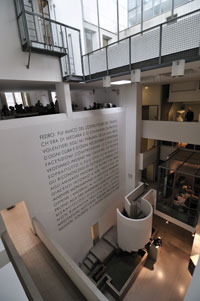
Connecting room
The first exhibition room acts as an historical introduction to the origins of the museum and the constitution of the collection. A number of panoramic views of Trieste, dating from the 1850s and 60s, are displayed. This was the period of Pasquale Revoltella’s maximum ascendancy and of the construction of the palace (lithographs and watercolours by Alberto Rieger). There are also portraits of the founder and of other patrons who, over the years, have bequeathed to the museum important works of art or even entire collections: Baroness Angela de Reinelt, Baroness Giuseppina de Brucker Oblasser, Baroness Emma de Luttheroth Petrettini, Baron Rosario Currò, and Carlo Piacere.
Entrance Hall and Ground Floor
The most outstanding feature of the interior of the Revoltella Palace is the winding staircase linking the three floors; ennobled by the presence of two marble groups by the Milanese sculptor Pietro Magni (1817 – 1877), the Fontana della Ninfa Aurisina (‘Fountain of the Aurisina Nymph’ – 1858) and the Taglio dell’Istmo di Suez (The cutting of the Suez isthmus – 1863).
The first group located at the foot of the staircase is an allegorical representation of the construction of Trieste’s second waterworks; an achievement of elevated technical complexity which was completed around 1850.

The female figure sitting on the sea shore represents Trieste receiving water from the Nymph who has just emerged from the caverns of the Carso in Aurisina. Two little angels, representing workmen and sailors, quench their thirst at her feet. The event takes place in the hollow of a sea shell which symbolises the sea.
Facing the staircase are the ground floor rooms, devoted to early 18th century art and display works belonging to the founder’s collection as well as paintings and sculptures purchased subsequently. The first two rooms contain sculptures dating from the Neo-classical period (a sketch by Canova portraying Napolean as Mars the peacemaker, a plaster cast portrait of Napoleon by J.J. Houdon and a marble bust of Felice Baciocchi by Lorenzo Bartolini) along with landscapes and scenery sketches by Giuseppe Bernardino Bison and fantasy landscapes by Lorenzo Scarbellotto.
The central room was originally occupied by a billiard table, unfortunately now lost. Its walls display historical paintings commissioned by Revoltella from local artists (Cesare Dell’Acqua, Augusto Tominz, Francesco Beda). Particularly worthy of mention are two paintings by Dell’Acqua depicting two significant episodes of Trieste’s history: Trieste’s dedication to Austria, 1382 (1856) and The proclamation of the free port, 1719 (1855).
The beautiful library is perfectly preserved in a corner room of the ground floor. It is entirely panelled with finely carved wooden shelves (especially notable are the portraits of scholars and philosophers crowning the bookcases) with books of considerable value and travel memoirs; in particular those concerning Revoltella’s visit to Egypt in 1861. A fake bookshelf, which is in fact a door, leads from the library to the apse room, now occupied by the sculptures described above but then used as the bathroom.
The opposite side of the central room leads to a selection of paintings by Giuseppe Tominz (1790 – 1866) the greatest portrait painter of neo-classical Trieste. A vast number of his individual and group portraits, which were much sought after by the city’s rich middle class, are here displayed.
This section of the palace ends with a room which is dedicated to early 18th century views of Venice (Angelo Inganni, Ippolito Caffi, Giuseppe B. Bison) and Milan (Carlo Canella and Giuseppe Migliara).
Baron Revoltella’s private apartment
Upon reaching the first floor landing in the vestibule, featuring a fine polychrome marble-like paving and four columns in Polcevera green marble, attention is caught by the second allegorical marble group by Pietro Magni. The cutting of the Suez isthmus, 1863 is placed on a high dark plinth.
A graceful female figure, representing Europe, unites the Mediterranean Sea and the Red Sea – two male figure sitting by her side and holding her hand. At the centre the god Mercury benevolently observes the event and indicates to Navigation the new route. Partly hidden, the fame’s genie writes down the names of those who took part in the great venture.
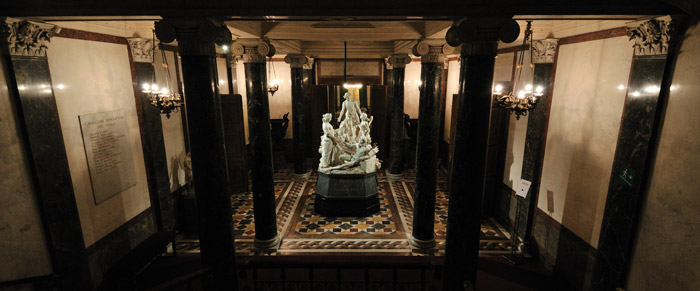
The evocative power of the sculpture is enhanced by the light that falls from above. The rooms opening to the right of the staircase are the private dining room (still lined with the original wood-like wallpaper) followed by the master bedroom, with the original brass bedstead and various pieces of quite simple furniture made of American maple. An amusing detail is the peep-hole in the corner sitting room which allowed discrete observation of the square facing the palace. The walls are hung with middle-eastern landscapes, a very popular genre at the time.
The most evocative room on the first floor is, however, the large green sitting room with its sumptuous gilded furniture enriched with Egyptian alabaster. The room is entirely decorated in Venetian stucco, like the walls of the main staircase, and holds a large portrait of Pasquale Revoltella painted in 1862 by Tito Agujari, as well as a portrait of Baron Carlo Ludovico de Bruck by Giuseppe Tominz. Two convex mirrors hang one at each side of the entrance creating an unusual effect of image deformation and spatial elongation. The chandeliers are the original ones.
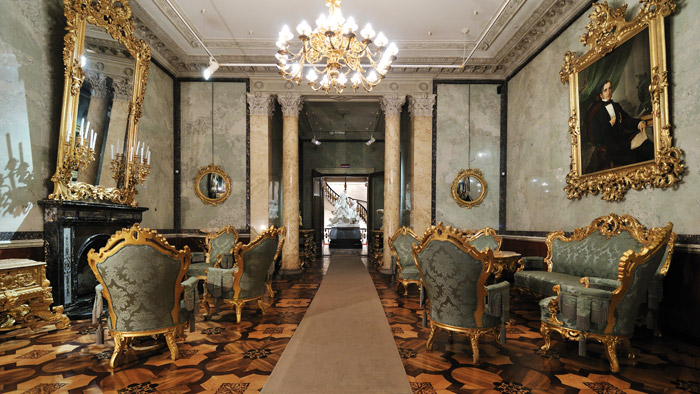
The adjacent “red room” is another small sitting room, decorated with dark furniture and an oriental-style chandelier and its walls display female portraits by the Venetian artist Natale Schiavoni (1777 – 1858). This room leads to the “study”, which was Revoltella’s office, dominated by the original wide desk with leather armchair, as well as a high writing table and paintings of the most significant places in Revoltella’s life: The Suez Canal (Alberto Rieger, 1864), and the Hunters Hill residence (Eugenio Pizzolato, 1858), his summer residence. The portrait by Giuseppe Tominz of Alessandro Goracuchi hangs next to the fireplace. Goracuchi was a well-known 19th century Triestine doctor and scholar who took care of the Baron during his long illness.
All the rooms have recently been restored with upholstery and curtains re-proposing the original colours; following descriptions in the inventory drawn up at the Baron’s death. Many of the first and second floor rooms still preserve the fine inlaid wooden flooring, the painted or coffered ceilings, the decorations in Venetian stucco, wallpaper or upholstery and many of the original furnishings. The last room on the first floor contains two historical paintings, Gioas’s coronation (1839) by Francesco Hayez and Alcibiades among the Hetaerae by Cosroe Dusi as well as a finely carved wooden table with four chairs – made for Revoltella by the Capuchin friars of Trieste as a token of gratitude for his financial support of their church.
The state rooms
Reception rooms
The elegantly furnished and elaborately decorated second floor rooms were reserved for the frequent and splendid receptions hosted by Revoltella. The vestibule which opens onto the floor below is lit by a skylight and decorated with four large marble statues representing the four seasons. Four marble busts by Luigi Gerrari portray four famous philosophers: Newton, Descartes, Galilei and Leibnitz. These are placed along the curved wall of the staircase alternating with decorative motifs of a symbolic nature relating to science and the arts.

The first room on the right was used for gala dinners. It is occupied by a large table seating thirty six. The walls are in white stucco with gilded finishes and the upper sections display decorative motifs on the theme of hunting. The marble fireplace is adorned with fine statuettes and crowned by a large mirror reflecting the light of three majestic crystal chandeliers with extensions with floral decorations.
There follows the so-called “blue sitting room” dominated by the portrait of Archduke Maximilian (painted by Augusto Tominz in 1868, one year after his execution in Mexico) and decorated with refined dark wood furniture, enriched with metal inlays, matched by the chandelier of the room. In a corner sits a fine majolica stove, recalling Austrian interiors, adding a touch of originality to the overall tone of the house which appears to be mostly inspired by a French style.
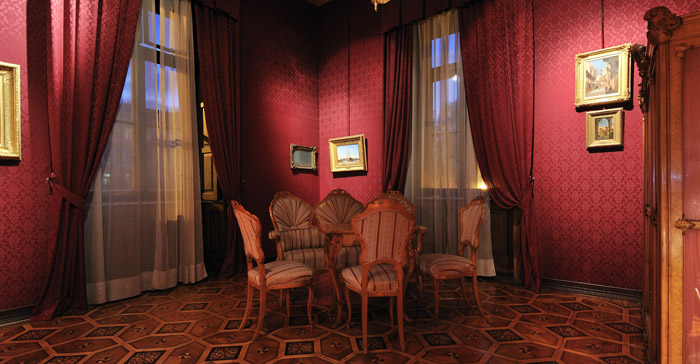
The small “red sitting room” in the far corner has another peephole for looking out and preserves its original upholstery. In the centre is the ballroom, entirely covered with fake green and red marble and lit by a second skylight and by French windows opening on the façade’s terrace. The ceiling is decorated with a cycle of seventeen paintings with different geometric shapes and that deal with the theme of Arts and professions (1859) by artist Augusto Tominz (a historical painter and son of the portrait painter Giuseppe, who received a number of commissions from Revoltella and was to later become the first curator of the museum). The walls have two landscapes attributed to Abraham Hondius and a large landscape with figure, attributed to Marco Ricco, these being the only pre-19th century paintings in Revoltella’s collection.
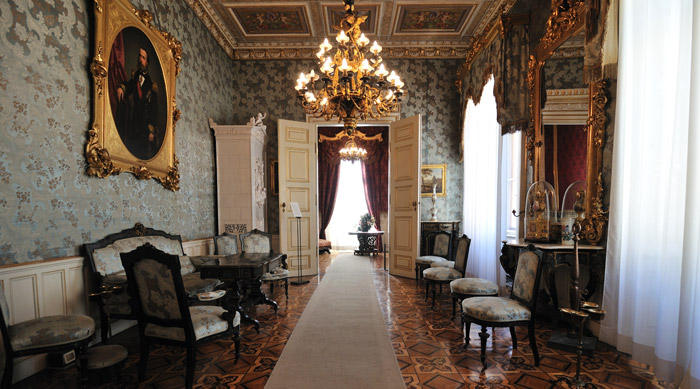
There follows the “chamber of mirrors”, another corner sitting room containing a group of allegorical statures, set in four deep niches, representing Song, Dance, Comedy and Harmony and, like most of the sculptures decorating the palace, is by Pietro Magni. From there we reach the “yellow sitting room”, a room that yet again was intended for conversation. It is furnished in fine dark wood with two large mirrors.
In one corner a marble bust of Pasquale Revoltella stands (1859), also by Magni and as a later addition a large Sèvres porcelain vase given by King Louis XVIII to the patrician Burlo family as a token of gratitude burying the Princesses Maria Adelaide and Maria Vittoria in their family tomb in San Giusto The princesses had died in exile in Trieste. The funerals are represented on the neck of the vase whilst the medallions contain the portraits of the two princesses. The piece was purchased by the City Council in 1875.
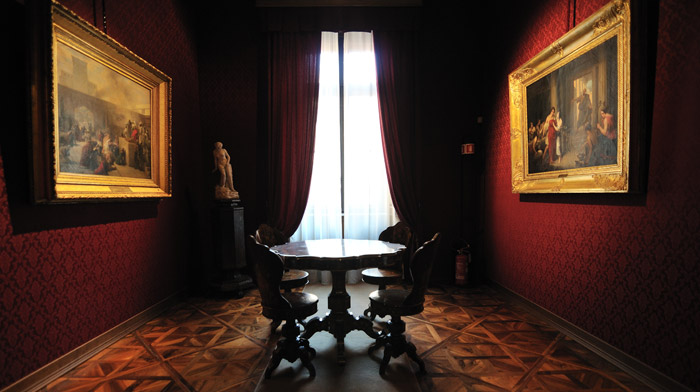
The tour of the palace ends in the small “domed chamber” with walls in Pompeian red, naturalistic motifs painted on the domed ceiling and niches with small bronze fountains from which water once gushed. At the centre stands one of the earliest sculptural pieces to enter Revoltella’s collection: Fidelity (1846), an allegorical group by the Hungarian artist Giovanni Simkovits.

